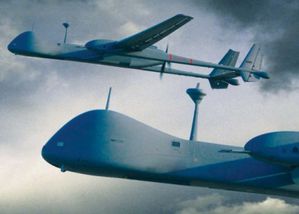Oct 12, 2012 Spacedaily.com (UPI)
Tel Aviv, Israel - Israel Aerospace Industries, flagship of the Jewish state's defense sector, is reported to have secured a $958 million contract from India's military to upgrade its IAI-built Heron and Searcher unmanned aerial vehicles.
UAVs are one of the biggest money-spinners for Israel's defense industry and India, which is engaged in a massive multiyear rearmament program, is a key customer.
Israel's Globes business daily cited Indian media reports that the deal covers some 150 UAVs acquired from IAI since the 1990s that are operated by India's army, air force and navy.
The Indian army deploys around 100 Searchers along the country's western, eastern and northern borders. The air force employs Searcher IIs and Herons for reconnaissance and surveillance missions.
"Once the upgrades are complete, the air force will be able to use the aircraft for long-range missions and control them through satellite communications systems," Globes reported.
Israel is one of the world's leading arms exporters, with most of its key customers in the developing world.
The U.S. Congressional Research Service at the Library of Congress reported in August that from 2004-11, Israel signed arms transfer agreements worth $12.9 billion. That ranked it as the eighth largest arms supplier in the world, behind the United States, Russia, France, Britain, Germany, China and Italy.
IAI has had major dealings with India in recent years.
In early 2006, IAI and the Indian Defense Research Development Organization signed a $480 million contract on missile development. Israeli business sources said the deal was a major boost to IAI's orders backlog at a time when Israel's defense industry, a key revenue earner, had to grapple with a big dip in the global market.
IAI won a $1.1 billion deal with the Indian navy in 2009 to provide advanced Barak-8 tactical air-defense missile systems for its warships. The Indian army is jointly funding a project to adapt the Barak-8 into a multipurpose weapons system.
Also in 2009, Israel's Rafael Advanced Defense Systems secured a $1 billion contract with New Delhi for 18 Spyder surface-to-air missile systems by 2012.
IAI sold the Indian air force three Phalcon early warning aircraft worth $1.1 billion in 2004.
All told, Israeli companies have sold India weapons and other military systems worth more than $10 billion over the last decade or so. In 2007, the Jewish state replaced France as India's second largest arms supplier after Russia.
India has also expressed interest in Israel's Arrow-2 anti-ballistic missile system jointly manufactured by IAI and the Boeing Co. of the United States.
But the technology transfer involved could impede any sale since U.S. approval would be required.
With a significant slowdown in the growth of high-tech exports to the United States and Europe, Israeli defense exporters are shifting their marketing focus to Asia.
In 2010, Israeli defense sales reached $9.6 billion, with the three largest defense-oriented companies along employing 30,600 people.
In March, India blacklisted Israel Military Industries, a major arms manufacturer, for 10 years because of a 2009 bribery scandal that has dogged links between the Jewish state's defense industry and one of its biggest customers.
State-owned IMI is the main supplier of defense platforms for the Israeli military and is a significant exporter in the defense field. This sector that has become increasingly crucial to maintaining production lines and developing new systems at a time when the government is slashing Israel's defense budget.
The decision by the Indian government "is expected to significantly impact IMI's activities in India, as well as that of other Israeli defense firms," the liberal Haaretz daily reported following the announcement of the blacklisting.
"However," Oxford Analytica observed in a December analysis, "these industries are now facing a problem similar to the one they faced in the late 1970s and early 1980s, when they reacted quickly to the lessons learned during the 1973 war and the spate of airline hijackings.
"Systems invented at that time included UAVs and sophisticated airport security networks but for a while it was hard to sell these products.
"Both systems have since been adopted by the security forces of many countries and form the core of Israeli defense exports."












